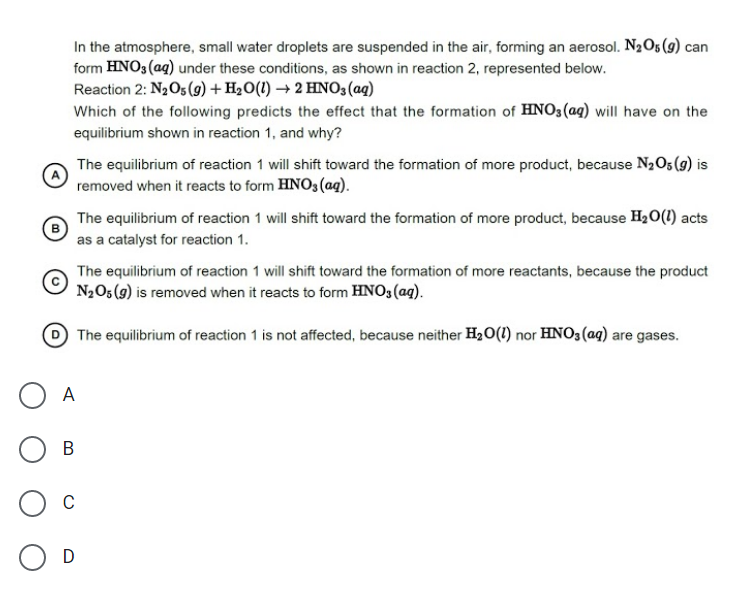In the atmosphere, small water droplets are suspended in the air, forming an aerosol. N2O5 (9) can form HNO3 (aq) under these conditions, as shown in reaction 2, represented below. Reaction 2: N2O5 (9) + H2O(1) → 2 HNO3(aq) Which of the following predicts the effect that the formation of HNO3(aq) will have on the equilibrium shown in reaction 1, and why?
In the atmosphere, small water droplets are suspended in the air, forming an aerosol. N2O5 (9) can form HNO3 (aq) under these conditions, as shown in reaction 2, represented below. Reaction 2: N2O5 (9) + H2O(1) → 2 HNO3(aq) Which of the following predicts the effect that the formation of HNO3(aq) will have on the equilibrium shown in reaction 1, and why?
Principles of Modern Chemistry
8th Edition
ISBN:9781305079113
Author:David W. Oxtoby, H. Pat Gillis, Laurie J. Butler
Publisher:David W. Oxtoby, H. Pat Gillis, Laurie J. Butler
Chapter16: Solubility And Precipitation Equilibria
Section: Chapter Questions
Problem 70AP
Related questions
Question

Transcribed Image Text:In the atmosphere, small water droplets are suspended in the air, forming an aerosol. N2O5(g) can
form HNO3 (ag) under these conditions, as shown in reaction 2, represented below.
Reaction 2: N2O5 (9) + H2O(1) → 2 HNO3 (aq)
Which of the following predicts the effect that the formation of HNO3(aq) will have on the
equilibrium shown in reaction 1, and why?
The equilibrium of reaction 1 will shift toward the formation of more product, because N2O5 (9) is
removed when it reacts to form HNO3 (aq).
The equilibrium of reaction 1 will shift toward the formation of more product, because H20(1) acts
as a catalyst for reaction 1.
The equilibrium of reaction 1 will shift toward the formation of more reactants, because the product
N2O5 (9) is removed when it reacts to form HNO3(ag).
The equilibrium of reaction 1 is not affected, because neither H20(1) nor HNO3(aq) are gases.
A
В
C
O D
Expert Solution
This question has been solved!
Explore an expertly crafted, step-by-step solution for a thorough understanding of key concepts.
This is a popular solution!
Trending now
This is a popular solution!
Step by step
Solved in 2 steps

Knowledge Booster
Learn more about
Need a deep-dive on the concept behind this application? Look no further. Learn more about this topic, chemistry and related others by exploring similar questions and additional content below.Recommended textbooks for you

Principles of Modern Chemistry
Chemistry
ISBN:
9781305079113
Author:
David W. Oxtoby, H. Pat Gillis, Laurie J. Butler
Publisher:
Cengage Learning

Chemistry: An Atoms First Approach
Chemistry
ISBN:
9781305079243
Author:
Steven S. Zumdahl, Susan A. Zumdahl
Publisher:
Cengage Learning


Principles of Modern Chemistry
Chemistry
ISBN:
9781305079113
Author:
David W. Oxtoby, H. Pat Gillis, Laurie J. Butler
Publisher:
Cengage Learning

Chemistry: An Atoms First Approach
Chemistry
ISBN:
9781305079243
Author:
Steven S. Zumdahl, Susan A. Zumdahl
Publisher:
Cengage Learning


Chemistry
Chemistry
ISBN:
9781305957404
Author:
Steven S. Zumdahl, Susan A. Zumdahl, Donald J. DeCoste
Publisher:
Cengage Learning

Chemistry for Engineering Students
Chemistry
ISBN:
9781337398909
Author:
Lawrence S. Brown, Tom Holme
Publisher:
Cengage Learning

General, Organic, and Biological Chemistry
Chemistry
ISBN:
9781285853918
Author:
H. Stephen Stoker
Publisher:
Cengage Learning